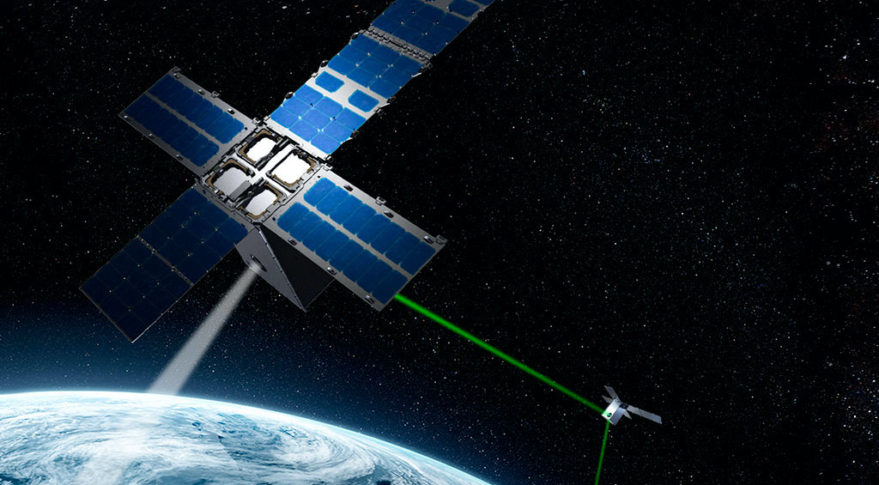
Satellite crosslinks using lasers, SDA image
WASHINGTON: The Space Development Agency (SDA) Director Derek Tournear sees lasers for inter-satellite links as the most important new tech to build a mesh network that will allow all-domain operations, as well as targeting of incoming hypersonic missiles.
“Optical crosslink technology, that’s number one. Tactical data links from space, that’s number two. And then the third one is the autonomous battle management to be able to get that networking system to fit together to actually form a mesh network and respond in real time,” he told the MilSatCom Digital Week opening event yesterday.
SDA currently is primarily focused on “beyond-line-of-sight targeting for time sensitive targets — so, for ships and mobile missiles. And, then, to do that same thing, beyond-line-of-sight targeting and tracking of advanced missile threats,” Tournear said.
Tracking modern ballistic and hypersonic missiles is the goal of one of the Low Earth Orbit (LEO) constellations being developed by SDA as part of it’s seven-layer architecture. The low-cost satellites are supposed to “provide missile warning and tracking information to national defense authorities, and tracking and cueing data for missile defense elements,” according to SDA officials. The plan is to launch the eight sats in 2022 and demonstrate the capability.
Those satellites, in turn, will rely on another layer of SDA satellites, the Transport Layer, for data relay. As Breaking D readers know, former Defense Secretary Mark Esper mandated that all the services use those satellites to link their command and control networks to the future Joint All-Domain Command and Control (JADC2) network. These optical satellite links are central to creating that C2 backbone.
SDA on Aug. 31 announced awards to Lockheed Martin and York Space Systems for $187.5 million and $94 million respectively for development of 10 satellites each for the Transport Layer constellation. The plan is for 20 satellites to be launched by September 2022, and provide a minimum capability as a mesh network.
However, laser links are also the proverbial long pole in the tent for SDA’s ambitions. Indeed, optical crosslinks and downlinks based on lasers for lightning fast satellites for communications and imagery transmission have long been a holy grail for DoD. For example, way back in 2003 the Pentagon launched the Transformational Satellite Communications System (T-SAT) that would have used both radio-frequency and laser comms to create mesh networks as an high speed parallel to the Advanced Extremely High Frequency (AEHF) encrypted and hardened communications satellite system. After paying Lockheed Martin and other companies more than $3.2 billion, DoD killed the program in 2009 when cost estimates ballooned.
Col. Ryan Colburn, head of Space Force Spectrum Warfare Division, agreed that optical crosslinks and mesh networks — satellite constellations that can exchange data in near-real time among themselves, down to fighters or ships or tanks and to ground stations that can re-route data globally — are crucial for the future.
But just as important, he told the MilSatCom conference, is the “ability to adapt what is fielded or being fielded, by updating it, pivoting it, so that our warfighting systems can operate through the threats that emerge.”
From the view of positioning, navigation and timing (PNT), the recent focus has been on the long-awaited M-Code to allow military GPS users to connect in a more secure manner. “It’s years in the making,” Colburn said. “It gives us that next-generation of GPS signal capabilities for improved anti-jam, anti- spoof, cryptology. And we’re almost finished, right, we’re turning the corner. … And we have the user equipment that it can use it so we’re well on our way.”
Indeed, the Space Force announced last Friday that it had approved “Operational Acceptance of GPS Military-Code (M-Code) Early Use (MCEU),” which is a hardware and software upgrade package for Lockheed Martin’s stop-gap GPS Operational Control System (OCS). The upgrade allows the M-Code to be used not just by the current GPS III satellites, but by all older GPS satellites that are M-Code capable (GPS IIR-M and GPS IIF satellites.) It also allows M-Code functioning to be monitored by ground controllers, as well as supporting testing and fielding of user equipment.
SpaceX successfully put up the fourth GPS III satellite, SV04, Nov. 5 on a Falcon 9 rocket after a month’s delay. That launch brought the number of working GPS satellites (new and old) with the M-Code enabled to 23, which means that commanders in the field now will be able to request early use of the M-Code signal.
Colburn said that following the M-Code, Space Force PNT efforts are focusing on lower-cost; smaller, less-costly atomic chip clocks for more precise timing; and cloud-based ground systems architectures “that allow us to do that ground based processing anywhere we need to, and give us that agility to move where our operations are really located.”
But beyond individual new technologies, Colburn stressed, is the requirement to be able to put all of the those new capabilities together. “Fundamentally, I think our opportunity and our challenge is to combine those capabilities in flexible and linked architectures,” he said.
Navy jet trainer fleet operations remain paused after engine mishap
One week after the incident, a Navy spokesperson says the service is continuing to assess the fleet’s ability to safely resume flight.


























